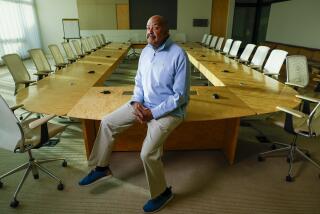Poll Says Residents Are Scroogelike About the Arts
- Share via
When it comes to giving money to the arts, an overwhelming majority of Orange County residents have a Scroogelike attitude, according to an annual countywide opinion poll released yesterday.
Their feelings--if truly representative--not only run counter to the explosive growth of county arts institutions over the last few years but underscore the doubts voiced by some fund-raisers in recent months about whether the growth can be sustained.
“Though I am reluctant to admit it, I think we’re seeing that people in the county don’t value their cultural institutions,” UC Irvine professor Mark Baldassare, who has conducted the poll since 1982, said Thursday.
“The big surprise,” he said, “is that with a highly educated and very affluent population, you usually get cultural sophistication. That doesn’t seem to be happening here.”
The Orange County Annual Survey polled 1,010 randomly chosen adults by telephone Sept. 7-20. They were asked to answer 90 questions about such issues as transportation, housing, the economy and quality of life.
This year, for the first time, the poll probed opinions on making charitable contributions to programs for the needy, churches, hospitals and medical causes, United Way, universities and arts institutions.
The poll found that while the county population is “very supportive of the concept of private giving,” it doesn’t put its money where its mouth is.
County residents “aren’t generous givers, compared to national figures,” the final report concluded. “On average, a county household gives less than 1% of its income” to all charitable causes. The median household donation was $262 last year, it noted.
Baldassare cited a 1985 national survey indicating that “the average American household gives 2.4% of its income to charity.”
The report concluded that cultural philanthropy in the county is the lowest charitable priority.
“Residents are least favorable of all toward giving to museums, arts and culture,” the authors wrote. “Only one in five is very favorable to these causes . . . (and) one in three is opposed to giving (at all).”
Such a finding is striking in light of increased budgets for the county’s major cultural institutions this year, much of which came from charitable donations. Furthermore, the $73-million Orange County Performing Arts Center in Costa Mesa, which opened last year and remains a towering symbol of the county’s arts explosion, was built solely with private contributions. The Center has also raised $4 million this year from county residents.
In addition to that paradox, the county poll contradicts national attitudes.
“Giving to the arts is the third-highest category, after religion and education,” Anne Murphy, director of the American Arts Alliance, a Washington-based lobbying group, said yesterday.
In telephone interviews with half a dozen arts administrators around the county, all of them pointed both to the Center and to their own expanded budgets as refutations of the survey’s finding.
“A substantial portion of our capital and operating funds came from individuals,” Center president Thomas Kendrick said yesterday. “We have the largest base of public support that I know of for a new institution of this kind.”
While he acknowledged that the Center depended heavily on corporate largess for its $11.5-million operating budget, he emphasized that there were 8,914 “small donors” who gave $26 to $999 this year and 16,000 “Friends of the Center” who gave $25 each.
“In fact,” he said, “we have the kind of support in this community that it took the Kennedy Center 25 years to build in Washington.”
Kevin Consey, director of the Newport Harbor Art Museum, pointed out that the museum’s $2.1-million budget for operations and art purchases “is about four times larger than it was four years ago.” Most of it came from individual donations and ticket sales, he maintained, and just 25% came from corporate contributions.
“If that’s not coming from the people, where is it coming from?” he asked.
At the South Coast Repertory in Costa Mesa, which has an operating budget of $4.6 million, producing artistic director David Emmes suggested that the survey contradicts his experience. “Our fund-raising campaigns have been extremely successful,” he said, adding that they have 3,500 annual donors.
Nevertheless, all the arts administrators conceded that they were not entirely surprised by the findings. And they argued that the growth of the arts institutions in the county is such a recent phenomenon that people have to be educated about how to support them.
“Cultural traditions aren’t very old and not deeply ingrained here,” said Harvey Stearn, president of the California Arts Council and a former member of the Performing Arts Center’s board of directors. “We just have to give it time.”
Stearn said in August that a trend toward diminished donations--a trend reflected by the survey’s findings--could mean serious problems for the county’s arts institutions, similar to the financial crisis faced by the San Diego Symphony in 1986.
Erich Vollmer, executive director of the Orange County Philharmonic Society, concurred. But he added that time may not be on the side of the arts groups because of growing competition for shrinking arts dollars. “The battle has become far more intense than ever,” he said.
The poll report did not analyze the reasons for the philanthropic attitudes of county residents, but Baldassare, a professor of social ecology and sociology, defended its accuracy.
“Nobody mentioned culture when they talked about quality of life,” he said. “Right now, the focus is not on the cultural institutions. Not for the middle class, nor even the affluent.”
More to Read
Sign up for Essential California
The most important California stories and recommendations in your inbox every morning.
You may occasionally receive promotional content from the Los Angeles Times.













